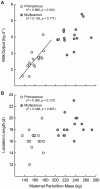The influence of reproductive experience on milk energy output and lactation performance in the grey seal (Halichoerus grypus)
- PMID: 21589918
- PMCID: PMC3092752
- DOI: 10.1371/journal.pone.0019487
The influence of reproductive experience on milk energy output and lactation performance in the grey seal (Halichoerus grypus)
Abstract
Although evidence from domestic and laboratory species suggests that reproductive experience plays a critical role in the development of aspects of lactation performance, whether reproductive experience may have a significant influence on milk energy transfer to neonates in wild populations has not been directly investigated. We compared maternal energy expenditures and pup growth and energy deposition over the course of lactation between primiparous and fully-grown, multiparous grey seal (Halichoerus grypus) females to test whether reproductive experience has a significant influence on lactation performance. Although there was no difference between primiparous females in milk composition and, thus, milk energy content at either early or peak lactation primiparous females had a significantly lower daily milk energy output than multiparous females indicating a reduced physiological capacity for milk secretion. Primiparous females appeared to effectively compensate for lower rates of milk production through an increased nursing effort and, thus, achieved the same relative rate of milk energy transfer to pups as multiparous females. There was no difference between primiparous and multiparous females in the proportion of initial body energy stores mobilised to support the costs of lactation. Although primiparous females allocated a greater proportion of energy stores to maternal maintenance versus milk production than multiparous females, the difference was not sufficient to result in significant differences in the efficiency of energy transfer to pups. Thus, despite a lower physiological capacity for milk production, primiparous females weaned pups of the same relative size and condition as multiparous females without expending proportionally more energy. Although reproductive experience does not significantly affect the overall lactation performance of grey seals, our results suggest that increases in mammary gland capacity with reproductive experience may play a significant role in the age-related increases in neonatal growth rates and weaning masses observed in other free-ranging mammals.
Conflict of interest statement
Figures




Similar articles
-
Primiparous and multiparous females differ in mammary gland alveolar development: implications for milk production.J Exp Biol. 2012 Aug 15;215(Pt 16):2904-11. doi: 10.1242/jeb.067058. J Exp Biol. 2012. PMID: 22837465
-
Repeatability in lactation performance and the consequences for maternal reproductive success in gray seals.Ecology. 2009 Sep;90(9):2513-23. doi: 10.1890/08-1386.1. Ecology. 2009. PMID: 19769129
-
Reproductive performance in grey seals: age-related improvement and senescence in a capital breeder.J Anim Ecol. 2006 Nov;75(6):1340-51. doi: 10.1111/j.1365-2656.2006.01157.x. J Anim Ecol. 2006. PMID: 17032366
-
Use of maternal reserves as a lactation strategy in large mammals.Proc Nutr Soc. 2000 Feb;59(1):99-106. doi: 10.1017/s0029665100000124. Proc Nutr Soc. 2000. PMID: 10828179 Review.
-
Adiposity and fat metabolism during combined fasting and lactation in elephant seals.J Exp Biol. 2018 Mar 7;221(Pt Suppl 1):jeb161554. doi: 10.1242/jeb.161554. J Exp Biol. 2018. PMID: 29514892 Review.
Cited by
-
Maternal Transfer and Long-Term Population Effects of PCBs in Baltic Grey Seals Using a New Toxicokinetic-Toxicodynamic Population Model.Arch Environ Contam Toxicol. 2022 Nov;83(4):376-394. doi: 10.1007/s00244-022-00962-3. Epub 2022 Oct 15. Arch Environ Contam Toxicol. 2022. PMID: 36242644 Free PMC article.
-
Estimating reproductive costs in marine mammal bioenergetic models: a review of current knowledge and data availability.Conserv Physiol. 2023 Jan 18;11(1):coac080. doi: 10.1093/conphys/coac080. eCollection 2023. Conserv Physiol. 2023. PMID: 36685328 Free PMC article.
-
Birth date promotes a tortoise or hare tactic for body mass development of a long-lived male ungulate.Oecologia. 2018 Jan;186(1):117-128. doi: 10.1007/s00442-017-4013-2. Epub 2017 Nov 21. Oecologia. 2018. PMID: 29164369
-
Incorporating effects of age on energy dynamics predicts nonlinear maternal allocation patterns in iteroparous animals.Proc Biol Sci. 2022 Feb 23;289(1969):20211884. doi: 10.1098/rspb.2021.1884. Epub 2022 Feb 16. Proc Biol Sci. 2022. PMID: 35168397 Free PMC article.
-
Sources of variation in maternal allocation in a long-lived mammal.J Anim Ecol. 2020 Aug;89(8):1927-1940. doi: 10.1111/1365-2656.13243. Epub 2020 Jun 29. J Anim Ecol. 2020. PMID: 32356304 Free PMC article.
References
-
- Clutton-Brock TH. Reproductive Success: Studies of Individual Variation in Contrasting Breeding Systems. Chicago: University of Chicago Press; 1988.
-
- Newton I. Lifetime Reproduction in Birds. London: Academic Press; 1989.
-
- Forslund P, Pärt T. Age and reproduction in birds - hypotheses and tests. Trends in Ecology and Evolution. 1995;10:374–378. - PubMed
-
- Curio E. Why do young birds reproduce less well? Ibis. 1983;125:400–404.
-
- Michel P, Ollason JC, Grosbois V, Thompson PM. The influence of body size, breeding experience and environmental variability on egg size in the northern fulmar (Fulmarus glacialis). Journal of Zoology. 2003;261:427–432.
Publication types
MeSH terms
LinkOut - more resources
Full Text Sources

